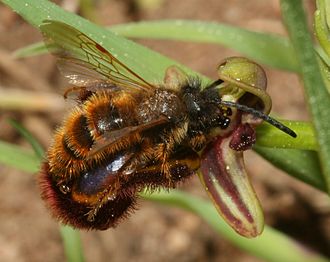
Back تطور مشترك Arabic সহবিবর্তন Bengali/Bangla Koevolucija BS Coevolució Catalan Koevoluce Czech Koevolution German Συνεξέλιξη Greek Coevolución Spanish Koevolutsioon Estonian Koeboluzio Basque

In biology, coevolution occurs when two or more species reciprocally affect each other's evolution through the process of natural selection. The term sometimes is used for two traits in the same species affecting each other's evolution, as well as gene-culture coevolution.
Charles Darwin mentioned evolutionary interactions between flowering plants and insects in On the Origin of Species (1859). Although he did not use the word coevolution, he suggested how plants and insects could evolve through reciprocal evolutionary changes. Naturalists in the late 1800s studied other examples of how interactions among species could result in reciprocal evolutionary change. Beginning in the 1940s, plant pathologists developed breeding programs that were examples of human-induced coevolution. Development of new crop plant varieties that were resistant to some diseases favored rapid evolution in pathogen populations to overcome those plant defenses. That, in turn, required the development of yet new resistant crop plant varieties, producing an ongoing cycle of reciprocal evolution in crop plants and diseases that continues to this day.
Coevolution as a major topic for study in nature expanded rapidly from the 1960s, when Daniel H. Janzen showed coevolution between acacias and ants (see below) and Paul R. Ehrlich and Peter H. Raven suggested how coevolution between plants and butterflies may have contributed to the diversification of species in both groups. The theoretical underpinnings of coevolution are now well-developed (e.g., the geographic mosaic theory of coevolution), and demonstrate that coevolution can play an important role in driving major evolutionary transitions such as the evolution of sexual reproduction or shifts in ploidy.[2][3] More recently, it has also been demonstrated that coevolution can influence the structure and function of ecological communities, the evolution of groups of mutualists such as plants and their pollinators, and the dynamics of infectious disease.[2][4]
Each party in a coevolutionary relationship exerts selective pressures on the other, thereby affecting each other's evolution. Coevolution includes many forms of mutualism, host-parasite, and predator-prey relationships between species, as well as competition within or between species. In many cases, the selective pressures drive an evolutionary arms race between the species involved. Pairwise or specific coevolution, between exactly two species, is not the only possibility; in multi-species coevolution, which is sometimes called guild or diffuse coevolution, several to many species may evolve a trait or a group of traits in reciprocity with a set of traits in another species, as has happened between the flowering plants and pollinating insects such as bees, flies, and beetles. There are a suite of specific hypotheses on the mechanisms by which groups of species coevolve with each other.[5]
Coevolution is primarily a biological concept, but researchers have applied it by analogy to fields such as computer science, sociology, and astronomy.
- ^ Cite error: The named reference
Pijlwas invoked but never defined (see the help page). - ^ a b Nuismer, Scott (2017). Introduction to Coevolutionary Theory. New York: W.F. Freeman. p. 395. ISBN 978-1-319-10619-5. Archived from the original on 2019-05-02. Retrieved 2019-05-02.
- ^ Thompson, John N. (2013-04-15). Relentless evolution. Chicago. ISBN 978-0-226-01861-4. OCLC 808684836.
{{cite book}}: CS1 maint: location missing publisher (link) - ^ Guimarães, Paulo R.; Pires, Mathias M.; Jordano, Pedro; Bascompte, Jordi; Thompson, John N. (October 2017). "Indirect effects drive coevolution in mutualistic networks". Nature. 550 (7677): 511–514. Bibcode:2017Natur.550..511G. doi:10.1038/nature24273. PMID 29045396. S2CID 205261069.
- ^ Thompson, John N. (2005). The geographic mosaic of coevolution. Chicago: University of Chicago Press. ISBN 978-0-226-11869-7. OCLC 646854337.